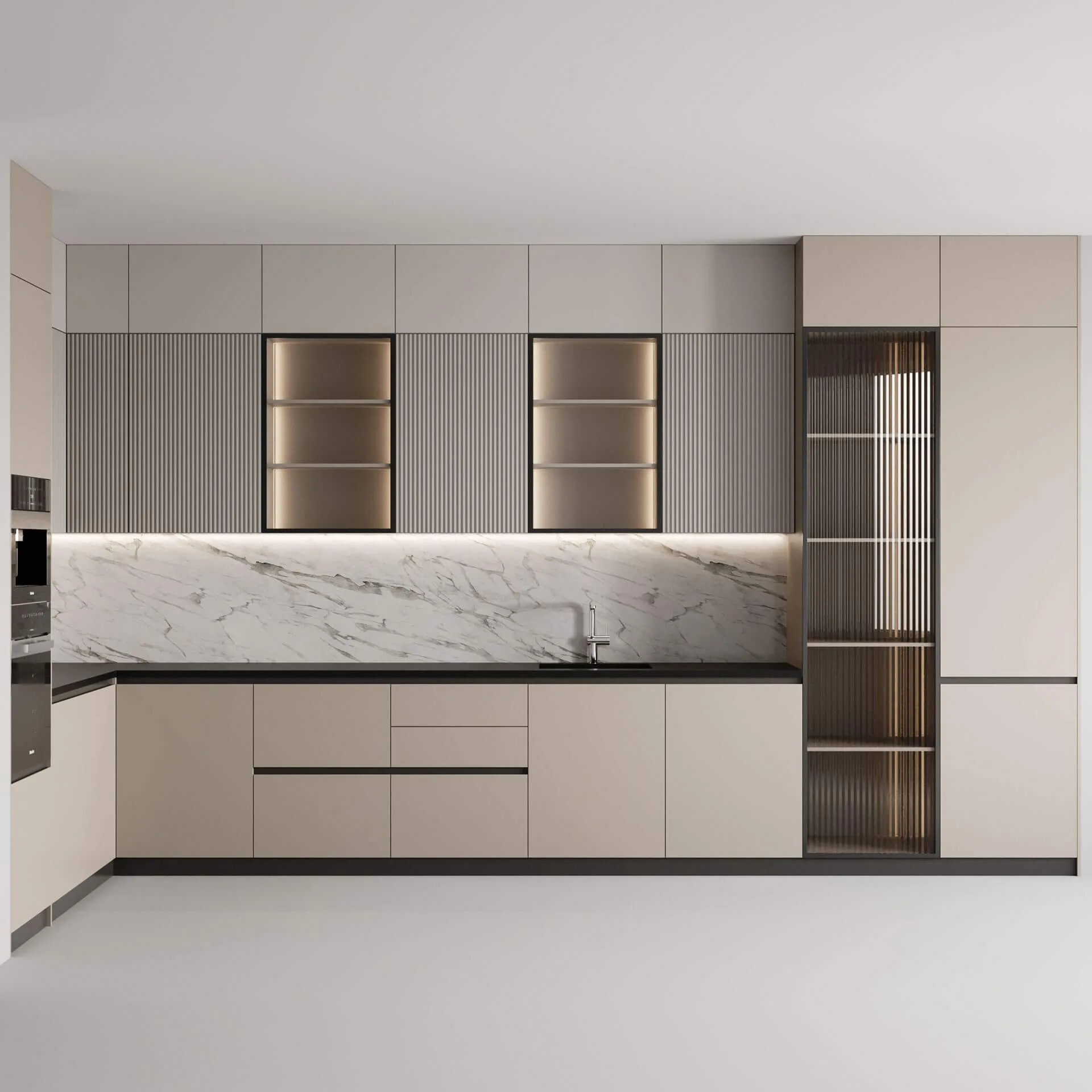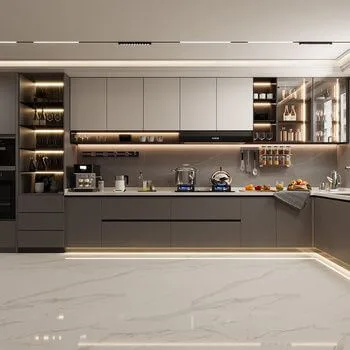Understanding the Needs of a Kitchen Light Fixture
The kitchen serves as a multifaceted environment where numerous tasks are performed, ranging from cooking and cleaning to socializing and dining. These varied activities necessitate specific lighting solutions to ensure an efficient and versatile space. Effective kitchen lighting should include a balanced mix of ambient, task, and accent lighting to meet the diverse needs inherent in this central part of the home.
Ambient lighting forms the foundation, providing general illumination that allows for easy navigation and overall visibility. It is typically achieved through ceiling-mounted fixtures such as recessed lights or flush mounts, which spread light evenly across the room. This type of lighting is essential for creating a welcoming and well-lit backdrop, setting the stage for other focused lighting types.
Task lighting plays a crucial role by illuminating specific areas where detailed activities occur. For instance, under-cabinet lights are effective for brightening countertops, thereby facilitating tasks such as chopping vegetables or reading recipes. Pendant lights over islands or sinks also offer targeted lighting, enhancing visibility for daily chores and food preparation. The key to effective task lighting is to minimize shadows and glare, thus ensuring safety and efficiency.
Accent lighting, on the other hand, is used to highlight particular features or to create visual interest within the kitchen. This could involve the installation of strip lights inside glass cabinets to showcase dishware or the use of directional spotlights to accentuate architectural elements. While accent lighting serves as a decorative touch, it also contributes to the overall functionality by breaking up large expanses of space and adding depth.
Proper illumination in the kitchen is not just about aesthetics; it significantly impacts functionality and safety. Adequate lighting reduces the risk of accidents such as cuts or burns and ensures that all tasks can be performed with precision. Therefore, striking the right balance among ambient, task, and accent lighting is essential for creating a kitchen environment that is both practical and inviting.
Types of Light Fixtures Suitable for Kitchens
When it comes to selecting a good light fixture for your kitchen, there are several options that cater to both aesthetic and practical needs. Each type of lighting serves a specific purpose and can be strategically placed to enhance the functionality and design of the kitchen. Here is an overview of the most common types of light fixtures suitable for kitchen environments:
Under-Cabinet Lights
Under-cabinet lighting is a highly functional type of fixture that illuminates countertops and workspaces. Ideal for food preparation areas, these lights minimize shadows and provide direct lighting where it is most needed. LED strip lights are a popular choice for under-cabinet lighting due to their energy efficiency and brightness. Additionally, this type of lighting can accentuate kitchen aesthetics by highlighting backsplash designs and countertops.
Pendant Lights
Pendant lights are versatile fixtures that hang from the ceiling, usually over kitchen islands or dining areas. They not only provide ample light but also serve as stylish design elements. The size, shape, and material of pendant lights can vary greatly, allowing homeowners to choose fixtures that complement their kitchen’s décor. Proper placement is key; it is recommended to hang pendant lights at a height that does not obstruct views but is low enough to provide adequate lighting.
Recessed Lighting
Recessed lighting, also known as can lights or downlights, is installed into the ceiling and provides a clean, unobtrusive look. These lights are excellent for general illumination and can be strategically placed throughout the kitchen to ensure even lighting distribution. Recessed lighting works well in kitchens with lower ceilings and can be used to spotlight specific areas such as sinks or stovetops.
Chandeliers
While traditionally used in dining rooms, chandeliers can add a touch of elegance to kitchens, especially in larger spaces or open-plan designs. Chandeliers provide not only functional lighting but also serve as eye-catching focal points. When selecting a chandelier, consider the kitchen’s size, ceiling height, and existing décor to ensure it complements rather than overwhelms the space.
Track Lighting
Track lighting consists of a linear strip that houses multiple adjustable light heads. This type of lighting is highly versatile and can be directed to illuminate various parts of the kitchen, from countertops to dining areas. Track lighting is beneficial in kitchens with irregularly shaped or large layouts, as it allows for customization in light direction and intensity. Additionally, it can be used to highlight specific design features like artwork or architectural elements.
In selecting the right kitchen light fixtures, consider both the functional demands and the aesthetic aspects of your kitchen space. The right lighting can significantly enhance the usability and visual appeal of your kitchen, making it a more enjoyable space to cook and entertain.
Choosing the Right Light Bulbs for Your Kitchen
Selecting the appropriate light bulbs for your kitchen is crucial in achieving desired visibility, ambiance, and energy efficiency. Modern kitchens benefit from various types of light bulbs, with LED, incandescent, and halogen bulbs being the most commonly used. Understanding the differences between these options will aid in making an informed decision.
LED (Light Emitting Diode) bulbs are the most energy-efficient choice available today. They consume significantly less electricity compared to incandescent and halogen bulbs, leading to substantial savings on energy bills. Additionally, LED bulbs boast an impressive lifespan, often exceeding 25,000 hours, which reduces the frequency of replacements. The light quality of LEDs is also superior, providing consistent illumination without flickering.
Incandescent bulbs, while traditional and familiar, are less energy-efficient. They generate light by heating a wire filament, which causes a significant portion of energy to be released as heat. This inefficiency results in incandescent bulbs having shorter lifespans, typically around 1,000 hours. Though they offer warm, flattering light, their disadvantages often outweigh their benefits in a kitchen setting.
Halogen bulbs, a type of incandescent bulb, are slightly more energy-efficient but still fall short when compared to LEDs. They emit a bright and crisp light, suitable for task lighting, and have a lifespan of about 2,000 hours. However, they also generate considerable heat, making them less ideal for energy-conscious households.
Color temperature is another critical aspect to consider when choosing kitchen light bulbs. Measured in Kelvins (K), color temperature ranges from warm (2,700K-3,000K) to cool (4,000K-5,000K). Warm light is ideal for areas such as dining nooks or islands, where a cozy ambiance is desired. Cool light enhances visibility for task-oriented zones such as countertops and stovetops, promoting a more functional workspace.
Finally, ensuring consistent lighting involves matching bulb specifications with your kitchen fixtures. Compatibility between the bulb and fixture ensures optimal performance and prevents issues such as flickering or premature burnout. Always check the recommended wattage and base type of both the bulb and fixture to achieve a harmonious kitchen lighting setup.
Placement and Installation Tips for Optimal Lighting
Proper placement and installation of light fixtures are crucial in creating a well-lit and functional kitchen environment. One of the essential aspects to consider is the height at which pendant lights should be hung. Ideally, pendant lights should be positioned around 30 to 36 inches above the countertop to provide adequate illumination for cooking and food preparation tasks without obstructing sight lines or conversation.
Another important element is the positioning of under-cabinet lights. To effectively eliminate shadows on the countertop, under-cabinet lighting should be installed towards the front edge of the cabinets rather than the back. This placement ensures even lighting, making it easier to see during food preparation. Moreover, these lights can serve as a lovely accent feature when the primary light fixtures are dimmed.
Recessed lights, also known as can lights or downlights, require careful spacing to guarantee uniform light distribution across the kitchen. A good rule of thumb is to space recessed lights approximately 4 to 6 feet apart, but this can vary depending on the size of the room and the wattage of the light bulbs used. Ensuring they are properly aligned and spaced will avoid dark spots and provide comprehensive illumination.
The incorporation of dimmer switches is strongly recommended to adjust lighting levels according to different activities and times of the day. Dimmer switches offer versatility, allowing for bright illumination during cooking and softer, ambient light when entertaining or dining.
Lastly, safety should always be a top priority during the installation of kitchen light fixtures. If opting for a DIY installation, ensure that the power is turned off before starting any electrical work. Always follow the manufacturer’s instructions and use the appropriate tools. However, for individuals lacking experience or confidence in electrical tasks, it is advisable to hire a professional electrician to handle the installation safely and effectively.


